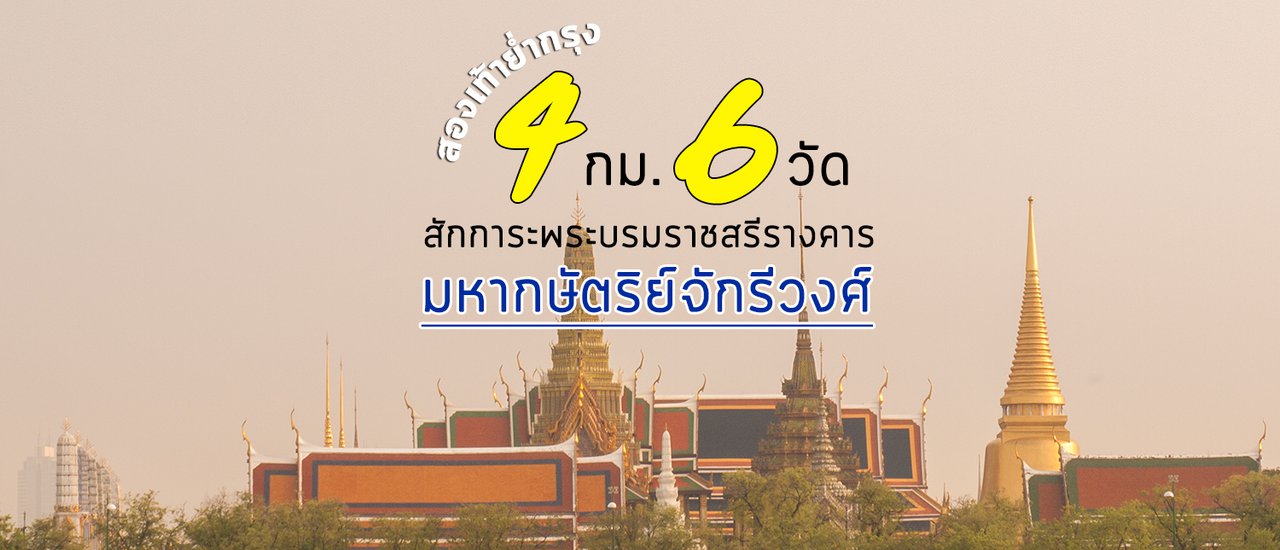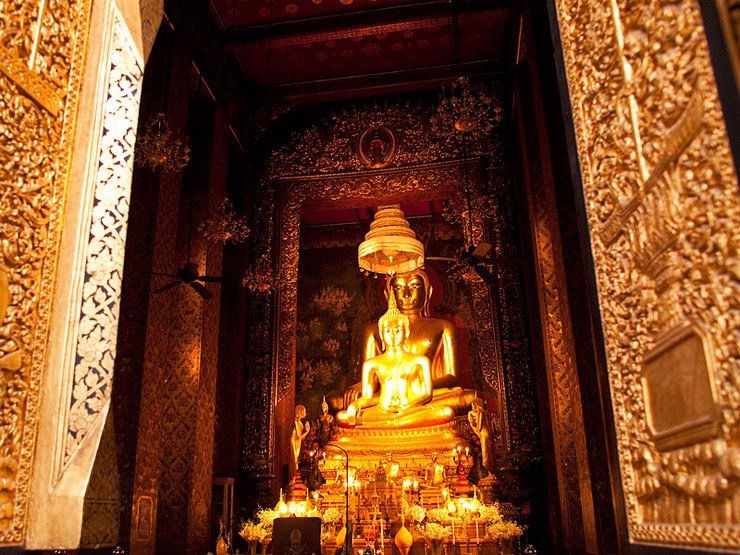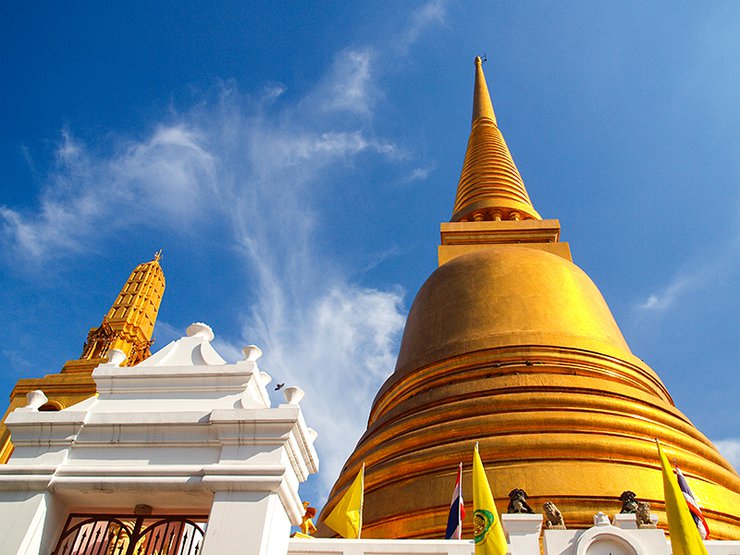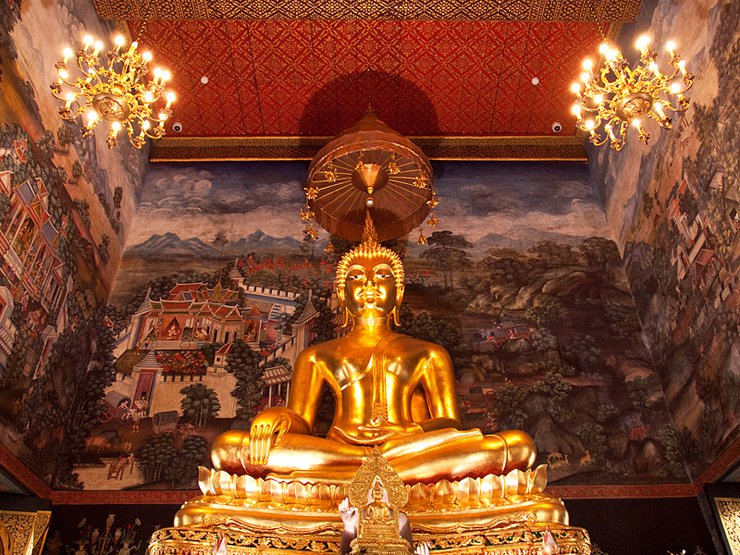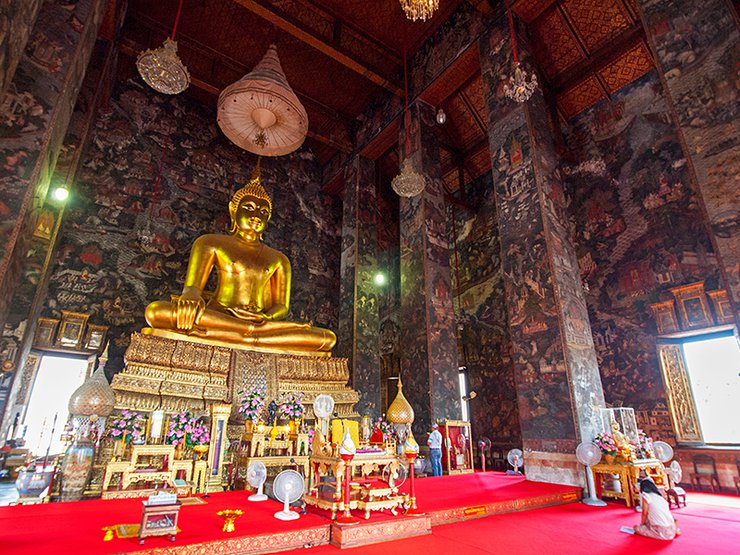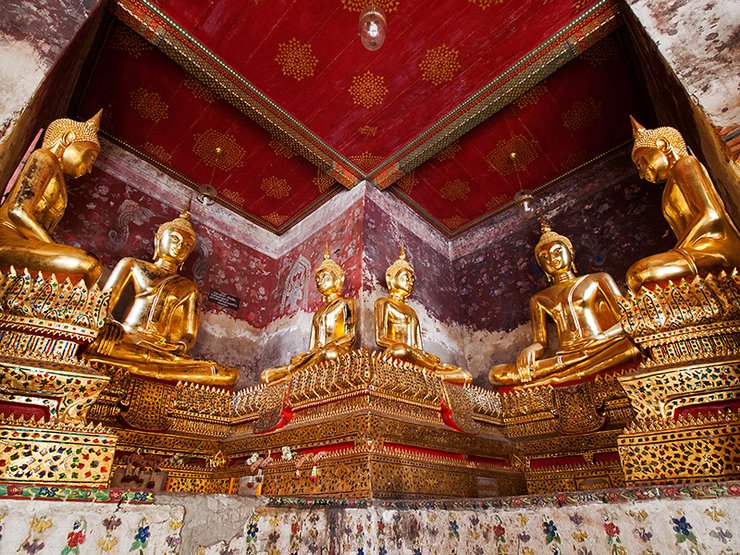Following the historic royal ceremony, many people are planning to pay their respects to the royal urn of His Majesty King Bhumibol Adulyadej at Wat Bowonniwet Vihara and Wat Ratchabophit Sathit Maha Simaram Ratchawaramahawihan. They also plan to visit the exhibition inside the Phra Meru Mas at Sanam Luang, which will be open from November 2 to 30.
In addition to the remains of King Rama IX, the royal urns of other monarchs of the Chakri Dynasty are also enshrined in various royal temples near the Grand Palace. These temples are within walking distance of each other, making it unnecessary to drive. I recommend walking as it is a more convenient option.
The temple where the royal ashes are enshrined and which serves as the temple of that particular reign are as follows:
- Wat Bowonniwet Vihara (King Rama VI and King Rama IX)
- Wat Suthat Thepwararam Ratchawaramahawihan (King Rama VIII)
- Wat Ratchabophit Sathit Maha Simaram Ratchawaramahawihan (King Rama V, King Rama VII, and King Rama IX)
- Wat Ratchapradithsathit Maha Simaram Ratchawaramahawihan (King Rama IV)
- Wat Phra Chetuphon Wimon Mangkhalaram Ratchawaramahawihan (King Rama I)
- Wat Arun Ratchawararam Ratchawaramahawihan (King Rama II)
The royal remains of King Rama III, King Nangklao, are enshrined at Wat Ratchaorot Saram Worawihan in Chom Thong district, Thonburi. Those who have enough time can try to visit all nine temples within a day to pay respects to the kings. Additionally, the royal remains of King Rama V are enshrined at Wat Benchamabophit Dusit Wanaram Worawihan, which is located outside the Grand Palace complex. It is not far away and can be easily reached by car.
How to walk the 6-temple route, approximately 4 kilometers, around the Grand Palace?

1. Starting from the Sanam Luang or the Royal Crematorium, walk along Ratchadamnoen Klang Road until you reach the Khok Wua intersection, the entrance to Khao San Road. Turn left onto Tanao Road and continue straight. Do not enter Khao San Road. The Wat Bowonniwet Vihara will be on your right shortly.
2. From Wat Bowon, walk back to Khok Wua intersection, turn left and walk to the Democracy Monument. Cross the road and walk straight along Dinsor Road to the Giant Swing. Walk along the side of Bangkok City Hall. At the Giant Swing is the entrance to Wat Suthat Thepwararam.
3. Exit the side of Wat Suthat on Tithong Road, walk straight until you reach the intersection, turn right onto Ratchabophit Road. Walk a little further and you will reach the back of Wat Ratchabophit Sathit Maha Simaram. You can enter the temple from the back.
4. From Wat Ratchabophit, exit through the cemetery side. The opposite side is Wat Ratchapradithsthit Mahasimaram. We then walk up the bridge over the Khlong Rop Krung and enter the temple through the side entrance, which is the Buddhavasa side.
- Departing from Wat Ratchabophit, walk towards the Grand Palace. Upon reaching Sanam Chai Road (Grand Palace wall), turn left and pass Saranrom Park. You will find the back of Wat Phra Chetuphon Wimon Mangkhalaram (Wat Pho). Cross the road and walk alongside the temple to enter the gate on the side of the Phra Buddha Saiyas (Reclining Buddha) wiharn.
6. Exit through the original gate at Wat Pho, cross the road to Tha Tien Pier, and take a ferry across the river to Wat Arun Ratchawararam Ratchawaramahawihan. Boats run regularly from morning to evening, and the fare is three baht.
Wat Bowonniwet Vihara (Rama VI, Rama IX)
The temple where King Rama IX was ordained as a monk, and where his royal ashes and those of King Rama VI are enshrined beneath the Phra Buddha Chinnasi, the principal Buddha image in the ordination hall. This ancient Sukhothai-era Buddha image was brought from Wat Phra Si Rattana Mahathat in Phitsanulok, along with the Phra Si Satsada, which is located within the wihan of Wat Bowon Niwet. Visitors are welcome to pay their respects.
The temple also houses a large golden stupa and, oh, another Buddha statue in the ordination hall behind the Phra Phuttha Chinnasi, namely Phra Phuttha Suwannachet, the original presiding Buddha image before Phra Phuttha Chinnasi was invited to be enshrined alongside.



The translation of "วัดสุทัศนเทพวราราม" is "Wat Suthat Thepwararam Ratchawaramahawihan".
This is a Buddhist temple in Bangkok, Thailand. It is one of the most important temples in the country and is a popular tourist destination. The temple was built in the 19th century and is known for its beautiful architecture and its large collection of Buddha statues.
The Suthat Temple is more familiar to people from the legend of the Suthat Temple's hungry ghosts and its location at the Giant Swing than from the fact that it was built during the reign of King Rama I and houses the royal ashes of King Rama VIII, enshrined in a celestial cloth in front of the Buddha Sakyamuni, the principal Buddha image in the vihara.
Wat Suthat, with its expansive grounds, offers more than just the main temple building. Visitors can pay respects to the principal Buddha image, Phra Buddha Trilokachet, housed within the ordination hall, and admire the exquisite murals adorning the walls.



Ratchabophit Sathit Maha Simaram Ratcha Wora Maha Wihan Buddhist Temple (King Rama V, King Rama VII, King Rama IX)
The last temple built according to the royal tradition that the king must build a temple for his reign, built as the temple for the reign of King Rama V. It has one of the most beautiful ordination halls in the country. The interior is decorated in a European Gothic style. The large pagoda is also decorated with yellow Benjarong tiles, which are very beautiful.
The royal cremains of King Rama V, King Rama VII, and King Rama IX are enshrined beneath the Phra Phuttha Angkhirasa, the principal Buddha image in the ordination hall. This Buddha image is crafted entirely from gold.
This temple also houses the Royal Cemetery, where the ashes and bones of members of the royal family are enshrined. Many of the monuments are built in a unique and beautiful Gothic style. Visitors are welcome to pay their respects.




Wat Ratchapradithsthit Maha Simaram (Rama IV)
The temple serves as a prototype for the Thammayut Nikaya sect, which was established by King Rama IV. His royal cremains are enshrined beneath the Phra Buddha Sihingkhapatimakorn, the principal Buddha image in the main wiharn (there is no ordination hall here). The main wiharn and the large stupa are adorned with beautiful marble.
This temple places a strong emphasis on the practice of Buddhist precepts and discipline compared to other temples. Visitors are expected to maintain a respectful and decorous demeanor during their visit.


Temple of the Emerald Buddha (King Rama I)
While the name Wat Phra Chetuphon may not be familiar to many, it is more commonly known as Wat Pho, the temple with the most foreign visitors after Wat Phra Kaew. With countless attractions, exploring Wat Pho could easily take an entire day. However, the image that has gained worldwide recognition is the reclining Buddha, one of the largest and most beautiful in Thailand.
The royal cremains of King Rama I are enshrined beneath the Buddha statue, the principal image in the ordination hall.



Temple of Dawn (Wat Arun Ratchawararam Ratchawaramahawihan) (King Rama II)
Wat Pho is always paired with Wat Arun, or the Temple of Dawn, just across the Chao Phraya River. Everyone knows the prang of Wat Arun. The temple also houses many sacred objects. Foreigners consider it another landmark of the capital city.
The cremated remains of King Rama II are enshrined beneath the Phra Buddha Dhamma Misra Ratcha Lokadhatu Dilok, the principal Buddha image in the ordination hall (พระอุโบสถ). It is important to note that the remains are located in the ordination hall, not the vihara. For those unfamiliar with the distinction, the vihara is decorated with glazed tiles depicting floral patterns, while the ordination hall features murals on the walls.


Follow my travel adventures on another channel.
http://www.facebook.com/alifeatraveller
นายสองสามก้าว / A Life, A Traveller
Friday, November 8, 2024 4:05 PM

